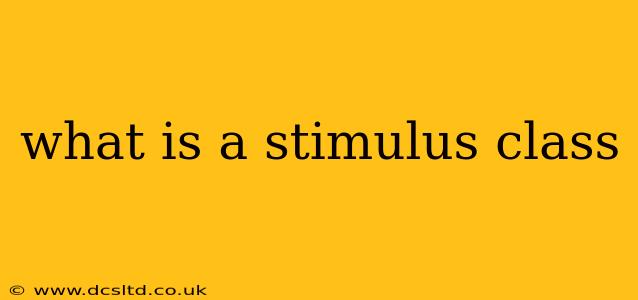A stimulus class is a group of stimuli that share a common characteristic and evoke the same operant response. In simpler terms, it's a set of things that are treated similarly because they elicit a similar reaction. This concept is fundamental to understanding behavior analysis, particularly in applied behavior analysis (ABA). Instead of responding to each individual stimulus uniquely, an organism learns to respond to the class of stimuli, exhibiting generalization across the shared features.
This differs from responding to individual stimuli, where each item would require separate learning. For example, imagine teaching a child to identify "red" objects. Instead of teaching them to identify each shade of red individually (e.g., scarlet, crimson, ruby), you teach them to identify the class of "red." This allows the child to correctly identify a wide variety of red objects, even those they've never encountered before.
What are the Different Types of Stimulus Classes?
Several types of stimulus classes exist, categorized by the relationship between stimuli:
1. Formal Stimulus Classes: These classes share physical similarities. Members look alike or have similar physical properties. Examples include:
- Color: All shades of blue form a formal stimulus class.
- Shape: Circles, squares, and triangles (though different) can be grouped as shapes.
- Size: Large objects, regardless of their other characteristics, constitute a formal class.
2. Functional Stimulus Classes: Members of this class evoke the same response, regardless of their physical similarity. Their shared property is their function, not their form. Examples include:
- Things that are edible: Apples, carrots, and cookies are dissimilar visually, but all evoke eating behaviors.
- Items you use to open doors: Keys, credit cards, and key fobs differ visually but function similarly.
- Words that are synonyms: "Happy," "Joyful," and "Cheerful" look different but share the same functional meaning.
3. Conceptual Stimulus Classes: These are the most abstract type. Members are linked by a learned relation or concept, such as:
- Animals: A dog, cat, and bird are different in appearance but belong to the concept of "animal."
- Food: A hamburger, salad, and pizza all fall under the concept of "food" even though they differ significantly in appearance and ingredients.
- Vehicles: Cars, buses, and bicycles are dissimilar but belong to the class of things used for transportation.
How are Stimulus Classes Formed?
Stimulus classes are formed through learning, primarily through the process of stimulus generalization. This occurs when an organism responds similarly to different stimuli because of shared characteristics. The more similar the stimuli, the more likely generalization will occur. Conversely, stimulus discrimination teaches an organism to respond differently to stimuli that vary in critical aspects. A dog trained to respond only to a specific whistle frequency is an example of stimulus discrimination.
Why are Stimulus Classes Important?
Understanding stimulus classes is crucial in several areas:
- Education: Teachers use stimulus classes to teach concepts and skills.
- Therapy: ABA therapists use stimulus classes to improve adaptive behaviors and reduce maladaptive ones.
- Animal Training: Trainers use stimulus classes to teach animals various commands and tricks.
How do Stimulus Classes relate to other Behavioral Concepts?
Stimulus classes are closely related to other key concepts in behavior analysis like:
- Generalization: The extent to which a learned response occurs to stimuli other than the training stimulus.
- Discrimination: The ability to differentiate between stimuli and respond differently to them.
- Reinforcement: The process that strengthens the likelihood of a behavior recurring.
In conclusion, a stimulus class represents a powerful tool in understanding how organisms learn and interact with their environments. By recognizing and applying the principles of stimulus classes, educators, therapists, and trainers can effectively shape behavior and foster learning across a variety of settings.
